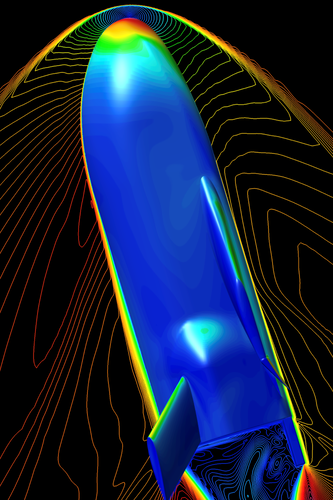This image models the passage of a spacecraft through the atmosphere using computational fluid dynamics. Every time a launch vehicle ascends into space, or reenters the atmosphere, its flight profile will have been simulated thousands of times by flight and aerothermodynamics specialists due to gather in Germany next month.
The 2nd International Conference on Flight Vehicles, Aerothermodynamics and Re-entry Missions Engineering, FAR 2022, concerned with all aspects of flying vehicles for launch and exploration, will take place on an in-person basis in Heilbronn in Germany on the week of 19-23 June, co-organised by ESA and national space agencies as well as the hypersonic flight association HyFAR-ARA.
The FAR series of conferences, running since 1998, aims to provide space agencies, companies, organizations, universities and research institutes with a forum of excellence in the area of flight vehicle engineering, aerothermodynamics, and reentry missions.
The conference encompasses the whole spectrum of flying vehicles for suborbital, orbital and exploration applications, including upper stages, (re)entry, expendable, and reusable vehicles. This year’s theme is Sustainable space: the keystone to the future!
Conference participants are invited to showcase their latest architecture designs, analysis and technical assessments with the aim to promote the exchange of ideas and the identification of new trends and required developments.
The field covered are flight vehicle engineering, flight physics, aerodynamics, thermodynamics and fluid dynamics engineering and the architecture design and analysis of space transportation and exploration vehicles.
This year’s conference comes at an exciting time, with two new European launchers close to completing their development – Ariane 6 and Vega-C – and a variety of smaller commercial launchers underway across our continent.
FAR 2022 will include dedicated workshops on the long-established launcher testing facilities at Lampoldshausen, home to the Institute of Space Propulsion of the German Aerospace Center DLR, as well as a variety of ambitious In-Orbit Demonstrator projects currently being supported by the Flight Vehicles and Aerothermodynamics Engineering section of ESA along with DLR.
These include a dedicated mission to gather data on high speed reentry physics – HEARTED, the Hyper-velocity Earth Re-entry TEchnology Demonstrator – and a human-in-the-loop lunar landing system. Other demonstrators include a CubeSat to observe the flight of ESA’s reusable Space Rider spacecraft, an exploratory drone to accompany a Moon rover, an air-breathing satellite for sustained very-low Earth orbits, a free-flying version of the HEXAFLY-int experimental waverider design and a DLR-led liquid-rocket engine demonstrator.
Other workshops within FAR 2020 focus on the results of EU-funded Horizon 2020 projects investigating key technologies for resuable vertically landing launchers and thermal protection systems suited for space vehicles returning from the Moon and Mars.
The conference will also include lectures on key scientific topics within the field, including current challenges for computational fluid dynamics supporting vehicle design, green propellants for New Space missions and the application of validation of aerothermodynamics databases to future missions.
For more information, including our preliminary programme, and full details of how to register, visit our FAR 2022 website. Registration closes on 6 June.
FAR 2022 organisers
FAR 2022 is being organied by ESA in conjunction with other space agencies and institutional partners, including the Deutsches Zentrum für Luft und Raumfahrt (DLR), the National Aeronautics and Space Administration (NASA), the Japan Aerospace Exploration Agency (JAXA), the the Centre National d’Études Spatiales (CNES) of France, the Agenzia Spaziale Italiana (ASI), the United Kingdom Space Agency (UKSA), the Spanish National Institute of Aerospace Engineering (INTA), the Norwegian Space Agency (NOSA), the Romanian Space Agency (ROSA), and the HyFAR-ARA association (HyFAR-ARA).

 Image:
Fly far, fly true
Image:
Fly far, fly true